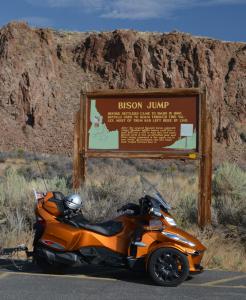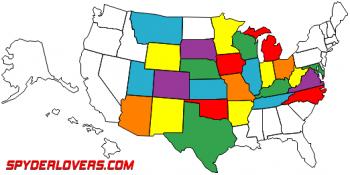|
-
SpyderLovers Sponsor


 Originally Posted by Possible

Not such a big deal for Harley's. They ran roller bearing cranks so all they needed was oil flow, pressure was relatively unimportant
Much different animal from the plain bearing cranks that require high pressure/flow. Put an oil pressure gauge on an old Harley and
you'd be lucky to see much measurable pressure at all.
Higher viscosities will give you higher oil pressures. Higher viscosities also tend to put more distance between lubricated parts. But higher viscosities do not dissipate heat as well as lower viscosities. As always, everything is a trade-off.
Components that have highly accurate tolerances do not need as thick an oil to keep them apart. What a lot of people do not realize is, a high quality oil in a well built engine actually keeps the hard parts from ever actually touching each other.
Shop Ph: 423-609-7588 (M-F, 8-5, Eastern Time)
Only SLOW people have to leave on time...


-

Yeah, all things being equal, you'll have higher temps with a 20W-50 than with a 10W-40 or 15W-40. With the old air cooled engines
it was always a trade off: better resistance to viscosity drop with a thicker oil and subsequent loss of oil film, or cooler running but
the possibility of parts actually touching with the lower weight oil, and too much loss of film strength. After many years of running 20W-50
Castrol GTX, I finally dropped down to a 15W-40 oil. It never caused me any oil related engine/transmission damage.
Peggy and Howard
Hers: 2013 Spyder ST-S SM5
His: 1999 Honda VFR Interceptor
-
Very Active Member


 Originally Posted by BajaRon

The larger the spread between the low an high numbers. The more susceptible the lubricant is to degradation and sheering. Optimally, you want an adequate low number for the condition (cold start up temperature) but not lower than needed. 10w is good down to zero for cold start-ups. Most Spyders never see a cold start-up below zero. So a 10w/40 or even a 15w/40 is actually a better option than a 5w/40 for the Spyder. For a snowmobile, which can sit outside in much colder weather, not so much. But the Spyder is not a snowmobile (at least without doing some significant modifications).
Different oils of the same viscosity will flow at different rates on start-up so these numbers are not universal. But the rule of thumb is 5w down to -30 F, 10w down to 0 F and 15w down to 15 degrees F. A true synthetic oil will flow better cold than a mineral oil with an additive package (labeled 'Synthetic) with the same cold start viscosity rating. And a mineral oil 'Synthetic' will flow better than a blended oil with the same viscosity rating at cold start-up.
We are talking cold start-up only here. The outside ambient temperature has no affect on the engine oil once it reaches operating temperature. You can ride (if you are crazy enough to do so) in sub-zero temps with a 10w, 15w or 20w low number oil without issue. Because once the oil starts to warm, you begin to move towards the high number in the viscosity spread. The oil only cares what the outside temperature is at cold start because it has assumed that same temperature. Yes, you want a lubricant that flows fast enough to protect engine parts and function hydraulic components. But you also want an oil thick enough to protect them at the same time. Don't forget, a good oil will retain a protective film on components between operations. Giving you protection during the start-up phase until pressurized oil arrives. Which happens very quickly. At start-up, there is little to no load on components, and a reason you should not rev the engine immediately after it starts.
Just trying to get my head around this. When does most wear occur, at start up or during hot running? I always thought at start so you wanted the easier flowing oil for tight tolerance engines. That the oil breaks down quicker because of the viscosity spread is the worse of the two evils is what you are advocating so better to use 10w ?
-
Very Active Member


 Originally Posted by ulflyer

FWIW, I recently came across are report on BITOG where a guy with a '16 F3L, 29K miles on it, changed his Amsoil with 9,600 miles on it; the Blackstone oil report showed it still good and recommended he try 12K next change. I know some folks can run their 1330's that long but I get in a dither if it gets to 5K. LOL
I know it's not directly applicable, but the oil change interval for a 1990 Acura I owned was 15,000 miles. And that was before full synthetics were an everyday on the shelf oil!

2014 Copper RTS
Tri-Axis bars, CB, BajaRon sway bar & shock adjusters, SpyderPop's Bumpskid, NBV peg brackets, LED headlights and modulator, Wolo trumpet air horns, trailer hitch, custom trailer harness, high mount turn signals, Custom Dynamics brake light, LED turn signal lights on mirrors, LED strip light for a dash light, garage door opener, LED lights in frunk, trunk, and saddlebags, RAM mounts and cradles for tablet (for GPS) and phone (for music), and Smooth Spyder belt tensioner.
-
Very Active Member


50 years ago Sinclair dino 30W oil would be so thick at -10F that you could take a pan of it and hold it upside down and nothing would fall or drip out!

2014 Copper RTS
Tri-Axis bars, CB, BajaRon sway bar & shock adjusters, SpyderPop's Bumpskid, NBV peg brackets, LED headlights and modulator, Wolo trumpet air horns, trailer hitch, custom trailer harness, high mount turn signals, Custom Dynamics brake light, LED turn signal lights on mirrors, LED strip light for a dash light, garage door opener, LED lights in frunk, trunk, and saddlebags, RAM mounts and cradles for tablet (for GPS) and phone (for music), and Smooth Spyder belt tensioner.
-
Active Member


 Originally Posted by Cobwebs

Just trying to get my head around this. When does most wear occur, at start up or during hot running? I always thought at start so you wanted the easier flowing oil for tight tolerance engines. That the oil breaks down quicker because of the viscosity spread is the worse of the two evils is what you are advocating so better to use 10w ?
My understanding is that viscosity spread is more of an issue with dinosaur oils, and not so much with synthetic. Some synthetics are actually dinosaur oils with extra refinement (group III), but if you use a PAO or Ester based oil the spread isn't so important. The argument there is for 0w as the bottom number. 0w oils still have a viscosity in the thousands (cSt) at 0°, but have a lower pour point. YMMV (I'm not over my head, but I'm up to my hairline)
Head in the game, eyes down the road... 2020RT
Spyder Tryke Pylot
2020 RT , Lamonster extender Petrol
-
Very Active Member


 Originally Posted by ButterSmooth

My understanding is that viscosity spread is more of an issue with dinosaur oils, and not so much with synthetic. Some synthetics are actually dinosaur oils with extra refinement (group III), but if you use a PAO or Ester based oil the spread isn't so important. The argument there is for 0w as the bottom number. 0w oils still have a viscosity in the thousands (cSt) at 0°, but have a lower pour point. YMMV (I'm not over my head, but I'm up to my hairline)
So if Mobil 1 or Amsoil which I presume are PAO/Ester based were available in a 5w40 they would be superior to a 10w40 in same in that they would cover a wider range of temperatures fluctuations and provide better start up lubrication without penalty or does the viscosity spread thing still win?
I know this all probably only means my engine is going to die at 300,000 miles rather than 299,000 but damn it it's an oil thread you know the rules!
-
Very Active Member


Just my opinion........ Most of the previous discussions of oil and weights is general information, with no allowances for the weather conditions in the area were the oil is most likely to be used. Maybe it doesn't matter so much if, you put the bikes away in winter anyway, it seems the weight of oil being used should consider the average temperature of the area. If you are traveling, then the average temperatures will vary and you make a choice. An area where the temperature rarely drops below freezing in winter and the temperature in summer averages 95 to 100 degrees in summer, would not require the same oil weights as an area where the summer riding season was very short and the winter temperatures drop well below zero. Like I said, maybe it doesn't matter if you store the bikes when it is freezing, but not all bikes are stored, even in freezing winter weather. Not so much the street bikes like the Spyders, but dirt bikes/ATVs/UTVs/etc. used on farms, for riding fence lines, checking livestock, or used by Forestry where roads are not in good condition, would still run in winter months. I know some people up north who ride street bikes right on through the winter, if the roads are plowed.
With a search engine of your choice, you can find hundreds of charts with the recommended oil weights in relation to the average temperatures to be encountered. Some of the charts are for cars, trucks, some for diesel, but there are also charts from many of the motorcycle manufactures. There is not one simple answer to such a complicated question. Any oil is better than no oil, but trying to match the weights to the average temperatures you expect should also play a role in selecting your oil. Saying one weight range fits all situations is leaving out a lot of the info the decisions are based on.
-
Active Member


 Originally Posted by Cobwebs

So if Mobil 1 or Amsoil which I presume are PAO/Ester based were available in a 5w40 they would be superior to a 10w40 in same in that they would cover a wider range of temperatures fluctuations and provide better start up lubrication without penalty or does the viscosity spread thing still win?
I know this all probably only means my engine is going to die at 300,000 miles rather than 299,000 but damn it it's an oil thread you know the rules!
Mobil 1 is a Group III oil, not a PAO or Ester. It started out as a Group IV (true synthetic), but soon changed. The hydrocarbons used to formulate Mobil 1 come from crude oil, so it is a 'Super Dino' oil. Amsoil doesn't release any information about their formulation. Keep in mind that almost any of these oils far exceed the requirements of modern engines.
Gwolf hit a very important consideration. My motorcycles are stored in my shop, which never sees temps lower then 45°, so I don't worry about the low number. But, if you park your rig outside, live where it gets cold, and have occasion to start the engine when cold, personally I'd use a 0w synthetic or as close as I could get. In my conditions 15w40 Rotella T6 would be great -- no worries about 5w40 T6 either. My Blackstone reports show no significant loss of viscosity (breakdown) and they always say 'go further next time.'
Head in the game, eyes down the road... 2020RT
Spyder Tryke Pylot
2020 RT , Lamonster extender Petrol
-
SpyderLovers Sponsor


 Originally Posted by Cobwebs

Just trying to get my head around this. When does most wear occur, at start up or during hot running? I always thought at start so you wanted the easier flowing oil for tight tolerance engines. That the oil breaks down quicker because of the viscosity spread is the worse of the two evils is what you are advocating so better to use 10w ?
Most wear does occur at start-up. All things being equal in a sound engine. So, you want an oil thin enough to be delivered quickly at start-up. But it is not as simple as just going to the thinnest oil possible. The oil's cold start temperature is the determining factor. As long as the oil flows well at the cold start temp, that is all you need. Since a 10w oil flows well down to zero degrees. This is more than enough for most Spyders.
A thinner oil will also have a lower pressure than a thicker oil. A thicker oil (as long as it is flowing well) will give you better lubrication and protection. If you don't need the thinner oil, you're better off with a higher viscosity. Add to this that you are narrowing the viscosity spread, improving oil life and longevity. And you get a win-win situation.
Last edited by BajaRon; 10-27-2020 at 01:10 PM.
Shop Ph: 423-609-7588 (M-F, 8-5, Eastern Time)
Only SLOW people have to leave on time...


-
SpyderLovers Sponsor


 Originally Posted by IdahoMtnSpyder

I know it's not directly applicable, but the oil change interval for a 1990 Acura I owned was 15,000 miles. And that was before full synthetics were an everyday on the shelf oil!
Your Accura does not run the engine oil through the transmission gear gauntlet. Transmissions are much harder on oil than an engine.
Shop Ph: 423-609-7588 (M-F, 8-5, Eastern Time)
Only SLOW people have to leave on time...


-
SpyderLovers Sponsor


 Originally Posted by ButterSmooth

My understanding is that viscosity spread is more of an issue with dinosaur oils, and not so much with synthetic. Some synthetics are actually dinosaur oils with extra refinement (group III), but if you use a PAO or Ester based oil the spread isn't so important. The argument there is for 0w as the bottom number. 0w oils still have a viscosity in the thousands (cSt) at 0°, but have a lower pour point. YMMV (I'm not over my head, but I'm up to my hairline)
It is true that true synthetic oils (engineered at the molecular level during refinement like Amsoil, Schaffer and a few others) have much less trouble with viscosity spread. This is because they can accomplish it with a very small amount of additives. Most 'Synthetic' oils are not really synthetic. They are the old mineral (dinosaur) oil with a large additive package. Since the oil molecules in mineral oil are relatively fragile, the additives are designed to give them a coating which helps protect them, for awhile, from crushing force. When these protective additives wear out, the oil shears quickly and you will usually lose about 1/2 of your viscosity rating within a relatively few miles. When you get a 'Blended' oil (like the BRP XPS), you're getting 90% straight mineral oil with about 10% mineral oil that has an additive package. I compare it to taking tap water and adding 10% pure spring water. Are you really improving the product all that much?
Shop Ph: 423-609-7588 (M-F, 8-5, Eastern Time)
Only SLOW people have to leave on time...


-
SpyderLovers Sponsor


 Originally Posted by Cobwebs

So if Mobil 1 or Amsoil which I presume are PAO/Ester based were available in a 5w40 they would be superior to a 10w40 in same in that they would cover a wider range of temperatures fluctuations and provide better start up lubrication without penalty or does the viscosity spread thing still win?
I know this all probably only means my engine is going to die at 300,000 miles rather than 299,000 but damn it it's an oil thread you know the rules!
It is my understanding that a true synthetic 10w oil will flow better than a 5w mineral oil with an additive package 'Synthetic'. It is a bit confusing because you would think all 5w oils would flow the same regardless of compound. You have to go to the actual flow numbers to get an accurate idea of each product. And who has time for that?
Last edited by BajaRon; 10-28-2020 at 07:02 AM.
Shop Ph: 423-609-7588 (M-F, 8-5, Eastern Time)
Only SLOW people have to leave on time...


-
SpyderLovers Sponsor


 Originally Posted by Gwolf

Just my opinion........ Most of the previous discussions of oil and weights is general information, with no allowances for the weather conditions in the area were the oil is most likely to be used. Maybe it doesn't matter so much if, you put the bikes away in winter anyway, it seems the weight of oil being used should consider the average temperature of the area. If you are traveling, then the average temperatures will vary and you make a choice. An area where the temperature rarely drops below freezing in winter and the temperature in summer averages 95 to 100 degrees in summer, would not require the same oil weights as an area where the summer riding season was very short and the winter temperatures drop well below zero. Like I said, maybe it doesn't matter if you store the bikes when it is freezing, but not all bikes are stored, even in freezing winter weather. Not so much the street bikes like the Spyders, but dirt bikes/ATVs/UTVs/etc. used on farms, for riding fence lines, checking livestock, or used by Forestry where roads are not in good condition, would still run in winter months. I know some people up north who ride street bikes right on through the winter, if the roads are plowed.
With a search engine of your choice, you can find hundreds of charts with the recommended oil weights in relation to the average temperatures to be encountered. Some of the charts are for cars, trucks, some for diesel, but there are also charts from many of the motorcycle manufactures. There is not one simple answer to such a complicated question. Any oil is better than no oil, but trying to match the weights to the average temperatures you expect should also play a role in selecting your oil. Saying one weight range fits all situations is leaving out a lot of the info the decisions are based on.
I think it is a matter of 'One size fits all'. Most customers do not want to delve into oil viscosities, flow rates, manufacturing methods, etc. They just want someone to tell them what oil to use and go on. 5w/40 will work in most situations that a Spyder will encounter. Yes, it may be too thin for warmer areas, or too thick for some extremely cold areas if you are starting you Spyder in sub-zero temps. But, though probably not ideal, neither is is likely to create any large issues.
If the customer would like an oil more tailored to their needs. The information and products are out there to accomplish this. Like everything else. Lubrication is very important to some. And a waste of time to others.
Shop Ph: 423-609-7588 (M-F, 8-5, Eastern Time)
Only SLOW people have to leave on time...


-
Very Active Member


 Originally Posted by BajaRon

Most wear does occur at start-up. All things being equal in a sound engine. So, you want an oil thin enough to be delivered quickly at start-up. But it is not as simple as just going to the thinnest oil possible. The oil's cold start temperature is the determining factor. As long as the oil flows well at the cold start temp, that is all you need. Since a 10w oil flows well down to zero degrees. This is more than enough for most Spyders.
A thinner oil will also have a lower pressure than a thicker oil. A thicker oil (as long as it is flowing well) will give you better lubrication and protection. If you don't need the thinner oil, you're better off with a higher viscosity. Add to this that you are narrowing the viscosity spread, improving oil life and longevity. And you get a win-win situation.
Through the winter here I noticed much harder starting to the point of a momentary oh crap the battery is dead, oh hang on no its right we're away.....just.
Cold battery or oil or both but makes me think a 10w would only exacerbate the problem.Here's what I use.
https://penriteoil.com.au/assets/pis...0ESTER)%20.pdf
Interestingly the manufacturer stipulates no substitute allowed,but no explanation given. They do have a 10w40 in their range which is why I am questioning its use.
-

Have a read from Motul .... some good advice that might rub a few here the wrong way.
https://www.advpulse.com/adv-preppin...m8X3c6CmRwJkJE
-
Active Member


 Originally Posted by Cobwebs

Through the winter here I noticed much harder starting to the point of a momentary oh crap the battery is dead, oh hang on no its right we're away.....just.
Cold battery or oil or both but makes me think a 10w would only exacerbate the problem.Here's what I use.
https://penriteoil.com.au/assets/pis...0ESTER)%20.pdf
Interestingly the manufacturer stipulates no substitute allowed,but no explanation given. They do have a 10w40 in their range which is why I am questioning its use.
They seem to hit all the hot specs. Viscosity index of 178! How expensive is that stuff?
Head in the game, eyes down the road... 2020RT
Spyder Tryke Pylot
2020 RT , Lamonster extender Petrol
-
Peggy and Howard
Hers: 2013 Spyder ST-S SM5
His: 1999 Honda VFR Interceptor
-
Very Active Member


 Originally Posted by ButterSmooth

They seem to hit all the hot specs. Viscosity index of 178! How expensive is that stuff?
Half the usual price of Mobil 1 or Amsoil if on special.3/4 if not.
-
Very Active Member


 Originally Posted by Cobwebs

Through the winter here I noticed much harder starting to the point of a momentary oh crap the battery is dead, oh hang on no its right we're away.....just.
Cold battery or oil or both but makes me think a 10w would only exacerbate the problem.Here's what I use.
https://penriteoil.com.au/assets/pis...0ESTER)%20.pdf
Interestingly the manufacturer stipulates no substitute allowed,but no explanation given. They do have a 10w40 in their range which is why I am questioning its use.
Not available stateside..

2022 RT Sea To Sky
--------------------------------
-
Very Active Member


 Originally Posted by troop

Not available stateside..
Paging all entrepreneurs............
-

 Originally Posted by Cobwebs

Through the winter here I noticed much harder starting to the point of a momentary oh crap the battery is dead, oh hang on no its right we're away.....just.
Cold battery or oil or both but makes me think a 10w would only exacerbate the problem.Here's what I use.
https://penriteoil.com.au/assets/pis...0ESTER)%20.pdf
Interestingly the manufacturer stipulates no substitute allowed,but no explanation given. They do have a 10w40 in their range which is why I am questioning its use.
That is what we use in the Spyder and my son's XVS however 10w40. Went with 10 due to the warmer (and less cold) climate up here. That may change if I spend the winter in Toowoomba rather than on the coast.
-
Very Active Member


 Originally Posted by glennm

That is what we use in the Spyder and my son's XVS however 10w40. Went with 10 due to the warmer (and less cold) climate up here. That may change if I spend the winter in Toowoomba rather than on the coast.
Penrite's advice is..........''No substitute allowed'' means that Penrite only recommend that one product for that particular application.No other product in the range should be used where this message is shown on the product selector.
The product selector for 1330 engines says 5w40 regardless. No mention of temperature differences go to a 10w.Only guessing here but the additive package may be superior to alternative brands that require a bit of old school thicker is better thinking, don't know not a scientist.I'm sticking with 5w frew fick or fin
-

Thanks Cobwebs will look at giving the 5 a go next oil change which is just before winter 2021.
-
Very Active Member


 Originally Posted by Possible

Considering the Spyder in question is Peggy's 2013 STS SM5, and waaaaay out of warranty, getting BRP to cover any warranty
issues is moot. And the engine in the Spyder is a detuned motorcycle engine, nothing special, and definitely not high performance,
or over stressed. There's nothing in the Spyder motor that necessitates any special oil. It's not much different from Harley-Davidson
recommending only Harley-Davidson oils for their tractor engines. All those oils are created by a few companies, unless BRP has their
own refinery, they are buying from somebody else.
Anyway, this is all just how I feel about motorcycle specific oils. I don't expect everyone, or maybe even anyone, to agree with me.
But I just feel I need to speak out when the motorcycle specific oil subject comes up. It comes up periodically on almost all motorcycle
forums I've ever been around for any time. I won't defend my views vociferously, because I just feel the way I feel. As always, freedom
of choice is a wonderful thing. Vote with your wallet, I do. 
I may be late to this party, so all of my comments may have been said already.
It's all about the wet clutch plates, not the motor. The motorcycle specific oils don't have the friction modifiers that will cause the manual clutch to slip.
I think Harleys, as well as most cars, have a transmission that is separate from the motor. The Spyder transmission shares the same oil as the motor.
If it ain't broke, don't break it.
IBA #47122
2020 RT Limited Asphalt Grey
 Posting Permissions
Posting Permissions
- You may not post new threads
- You may not post replies
- You may not post attachments
- You may not edit your posts
-
Forum Rules
|






 Reply With Quote
Reply With Quote




